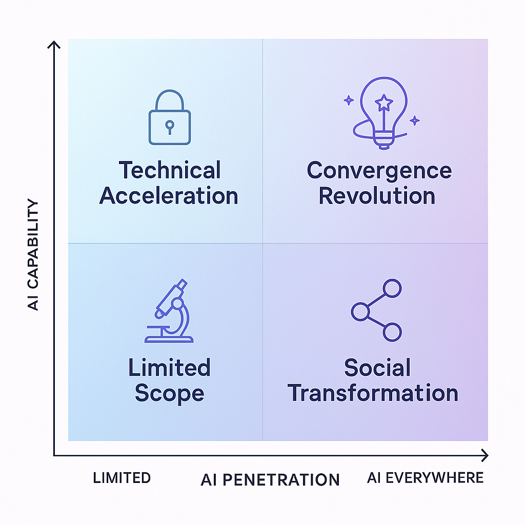Embrace the AI Tipping Point: How Entrepreneurs Can Prepare for Four Future Scenarios
August 13, 2025
Published in:
Artificial Intelligence is swiftly moving into our everyday reality, bringing with it the potential to reshape every sector. EO member and AI expert Robert van der Zwart shares scenario planning to outline four plausible AI futures by 2030—and the strategies entrepreneurs can adopt now to stay ahead in any outcome.

Contributed by Robert van der Zwart, an EO Netherlands member, who is a coach, keynote speaker, founder of AIPO Network, and a host and organizer of the virtual ‘EO Global AI Summit #3: Beyond Theory, AI At Work’ which took place 27 February 2025 with more than 1,800 registered attendees. Members can view Global AI Summit #3 on the EO Virtual Learning Platform.
Artificial Intelligence is no longer an abstract buzzword―it’s reshaping every sector and swiftly moving from boardroom strategy to everyday reality. For entrepreneurs, the stakes have never been higher or more uncertain. Where will AI take us in the next five years? And how can business leaders best prepare themselves for a world defined by "AI everywhere"?
Drawing on scenario planning principles pioneered by Shell, this post outlines four plausible futures for AI development and deployment by 2030. The aim: Empower entrepreneurs to anticipate the coming transformation and craft adaptive, resilient business strategies in advance.
The Two Axes Defining Our Future
Recent advances, including predictions from leaders at OpenAI and Google DeepMind, suggest that AGI (Artificial General Intelligence) is only a few years away, accelerating the pace of change. But the path ahead remains uncertain. We believe these uncertainties can be captured along two critical axes:
- Axis 1: AI Capability — From today’s powerful but domain-limited “narrow” AI to the emergence of AGI or even Artificial Superintelligence (ASI).
- Axis 2: AI Penetration — From limited, selective deployment to ubiquitous, seamless integration: "AI everywhere".

The Four Scenarios for 2030
1. Limited Scope (Narrow AI + Limited Penetration)
In the first scenario, AI continues to excel within well-defined problems―think medical diagnostics, fraud detection, or supply chain optimization―but lacks general reasoning and true adaptability. Deployment advances, but regulatory caution and cost barriers slow its transformation into society’s connective tissue.
What this means for you as an entrepreneur:
- Prioritize AI that enhances, not replaces, people—assist clients and teams in becoming more productive, not replaceable.
- Specialize in AI solutions for tightly regulated or high-trust industries (finance, healthcare).
- Become an expert in compliance, safety, and user trust to differentiate from tech-only players.
2. Technical Acceleration (AGI/ASI + Limited Penetration)
In the second scenario, breakthroughs deliver AGI’s long-promised leap in cognitive power, but access is tightly gated. Whether due to safety concerns, global governance, or deliberate restrictions on deployment, AGI remains confined to controlled settings (government, elite institutions, select tech companies), rather than the wild.
What this means for you as an entrepreneur:
- Build AI-native business models that leverage AGI within licensed or approved environments.
- Invest in technologies and services that safeguard deployment, monitor bias, and assure control.
- Partner with AGI custodians to shape safe, responsible, high-value applications—think AI-audited security or cognitive investment advisory.

More AI Strategy Resources:
Russell, S., & Norvig, P. (2021). Artificial Intelligence: A Modern Approach (4th Edition): Comprehensive textbook covering current AI capabilities, approaches, and prospects.
Bostrom, N. (2014). Superintelligence: Paths, Dangers, Strategies: Influential analysis of advanced AI futures and societal impact.
Yudkowsky, E. (2008). Artificial Intelligence as a Positive and Negative Factor in Global Risk: Outlines risks and benefits of advanced AI.
OpenAI, DeepMind, and Anthropic Research Blogs: For up-to-date perspectives and predictions regarding AGI timeline and technical progress.
Partnership on AI. (Ongoing): Industry best practices, whitepapers, and discussion papers covering transparency, fairness, and social impact.
West, D. M. (2018). The Future of Work: Robots, AI, and Automation: A clear overview of workforce transformation and adaptation needed for the AI era.
3. Social Transformation (Narrow AI + AI Everywhere)
In the third scenario, widespread “narrow” AI saturates society. From smart homes and cities to customer service, logistics, and personal health, AI is seamlessly embedded in daily life. Yet, each system still operates within clear functional limits.
What this means for you as an entrepreneur:
- Move from solving isolated problems to integrating diverse AI systems for end-to-end coordination.
- Develop privacy-preserving, user-centric AI platforms—not surveillance-first ones.
- Shape experiences and services that thrive on the “network effect” of ubiquitous intelligence.
4. Convergence Revolution (AGI/ASI + AI Everywhere)
In scenario four, AGI-driven intelligence is deployed throughout society. Autonomous agents interact—and even collaborate—with humans in virtually every arena, radically shifting society, business, and the very notion of work.
What this means for you as an entrepreneur:
- Be a builder of foundational infrastructure for AGI-era services—platforms, marketplaces, governance, and creativity tools.
- Innovate on business models for a potential post-scarcity world, focusing on experience, meaning, and human values over raw productivity.
- Lead in crafting new rules for autonomy, collaboration, and purpose at the intersection of humanity and superintelligent agents.
5 Strategic Moves to Future-Proof Your Venture
Regardless of which outcome becomes reality, some foundations are universal for entrepreneurs in this new age:
- Invest in AI literacy at all staff levels; stay ahead of regulatory and ethical trends.
- Develop modular business models and agile teams that can adapt to shifting technology and regulations.
- Prioritize human-centric value: empathy, ethical judgment, and creativity will remain irreplaceable.
- Adopt governance frameworks that go beyond compliance—build mechanisms for transparency and stakeholder alignment across borders.
- Forge partnerships across the AI ecosystem, from research labs to regulators, and advocate for inclusivity and digital equity.
Early Warning Signs: What to Monitor
- AGI and AI benchmark announcements from leading labs.
- New privacy, safety, or deployment regulations in your sectors and target regions.
- Rapid spikes in AI adoption rates in client/customer bases.
- Public sentiment shifts and labor market transitions.
Anticipate, Adapt, Lead
AI’s trajectory over the next five years will challenge every assumption about business as usual. The most successful entrepreneurs will not be those who merely react but those who anticipate change, build scenario-based strategies, and invest in the organizational agility and values to thrive—no matter which future arrives.
Are you ready to be one of them?
You may also be interested in additional posts by Robert van der Zwart:
- Why Leaders Must View AI as a Strategy Enabler, Not the End Goal
- 5 Ethical AI Pillars To Ensure Responsible Use in Your Organization
- How to Embrace Darwin's and Schumpeter's Ideas To Adapt and Thrive in AI Age